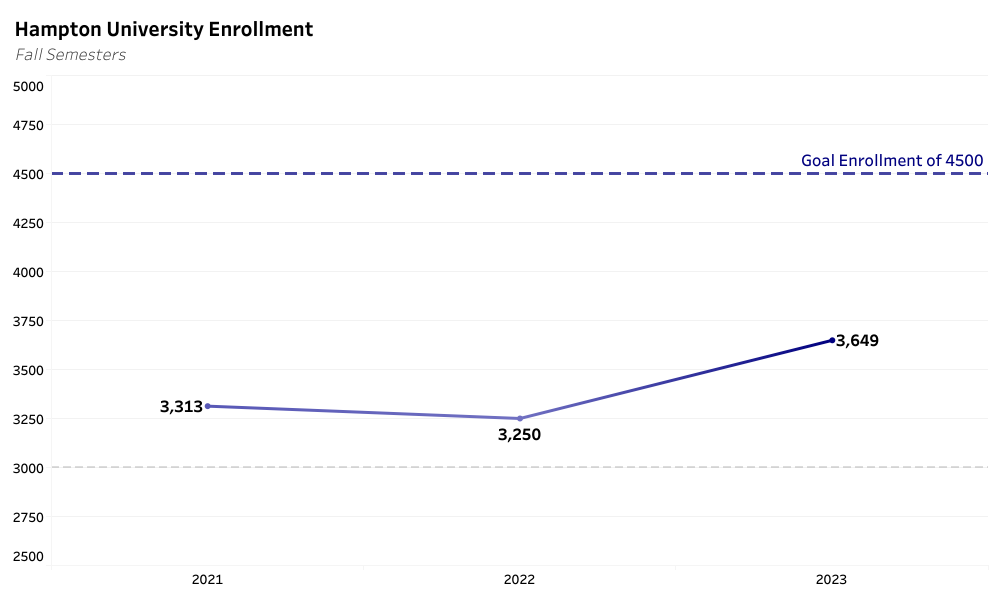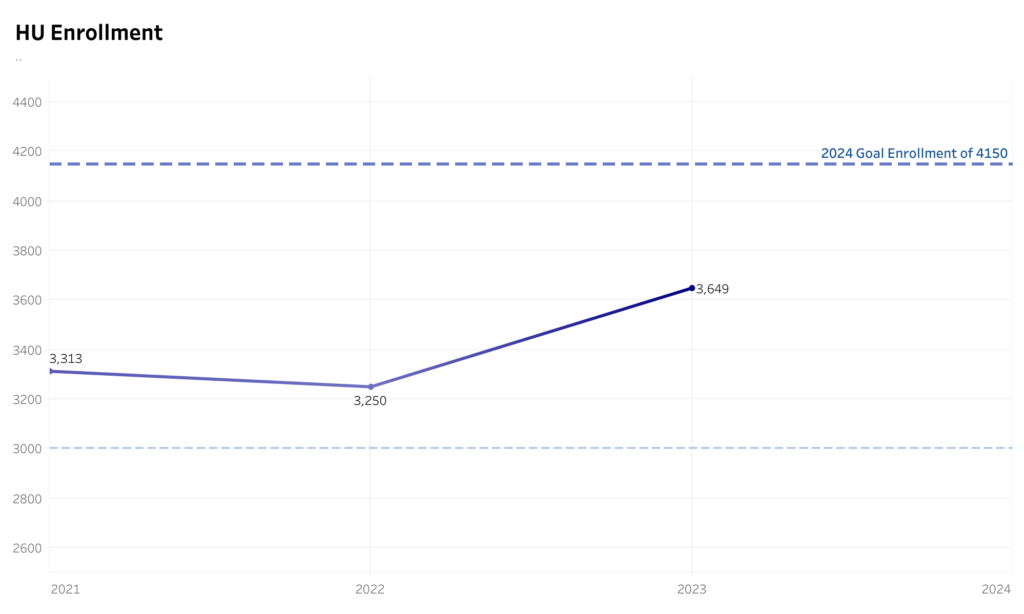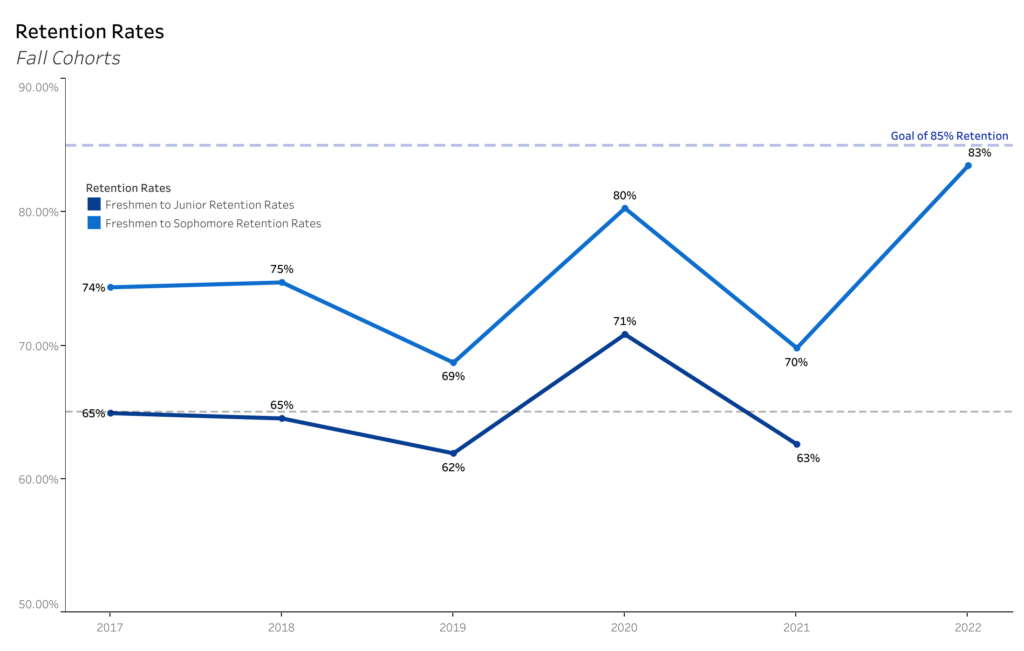ELEVATE ACADEMIC EXCELLENCE
GOAL
REIMAGINE THE HAMPTON ACADEMIC EXPERIENCE TO DEVELOP INNOVATIVE 21ST-CENTURY LEADERS OF CHARACTER FOR OUR COMMUNITY, OUR NATION, AND OUR WORLD.
INTRODUCTION
Hampton University positions academic excellence front and center among its goals so that it remains: a clear focus, an institutional standard, and a promise to university stakeholders as the entire Hampton family endeavors to deliver the #1 student experience in America. The strategies to achieve the principal goal are developed around the following: academic experience; academic inventory; policies, procedures, faculty; and undergraduate, graduate, and online enrollment.
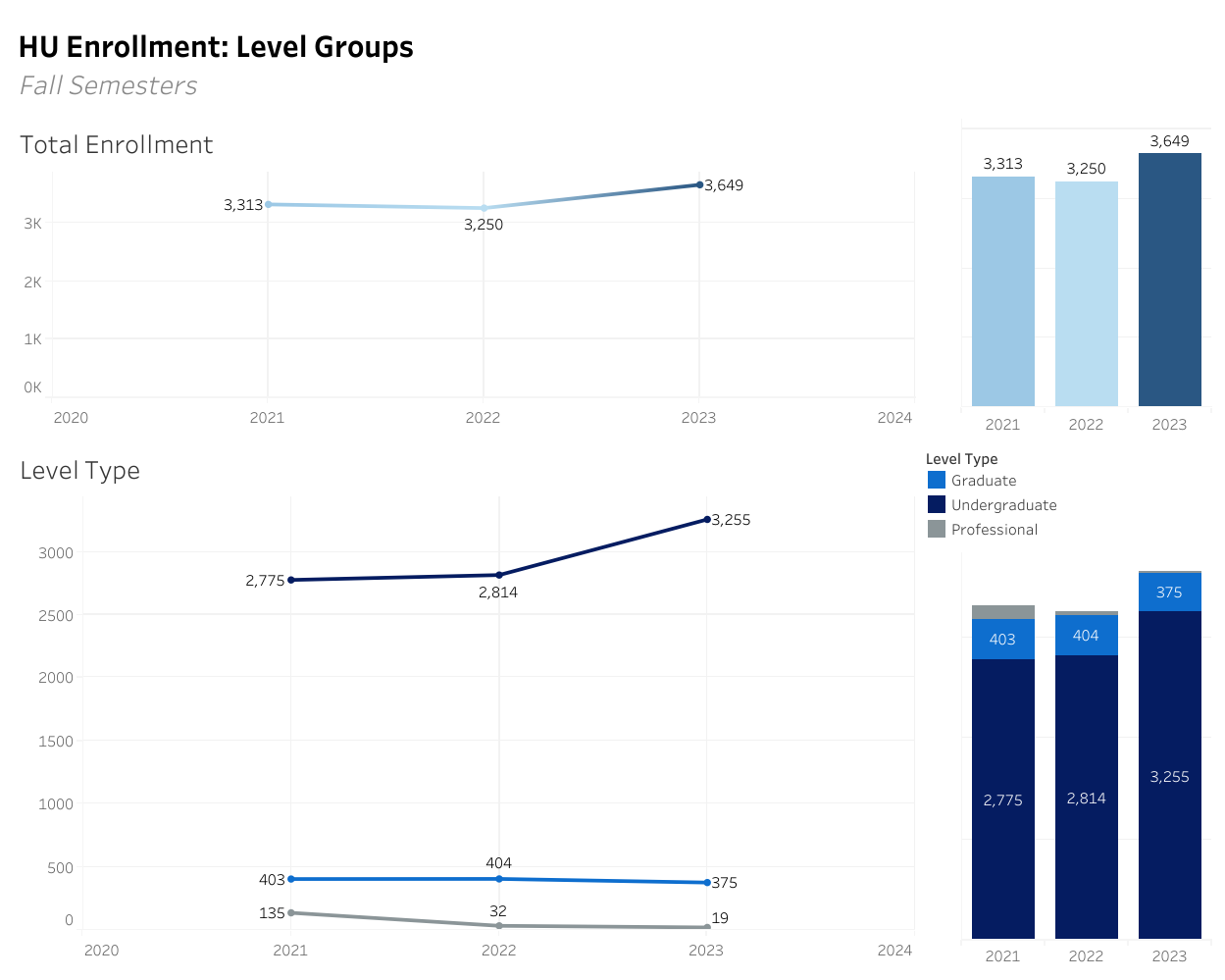

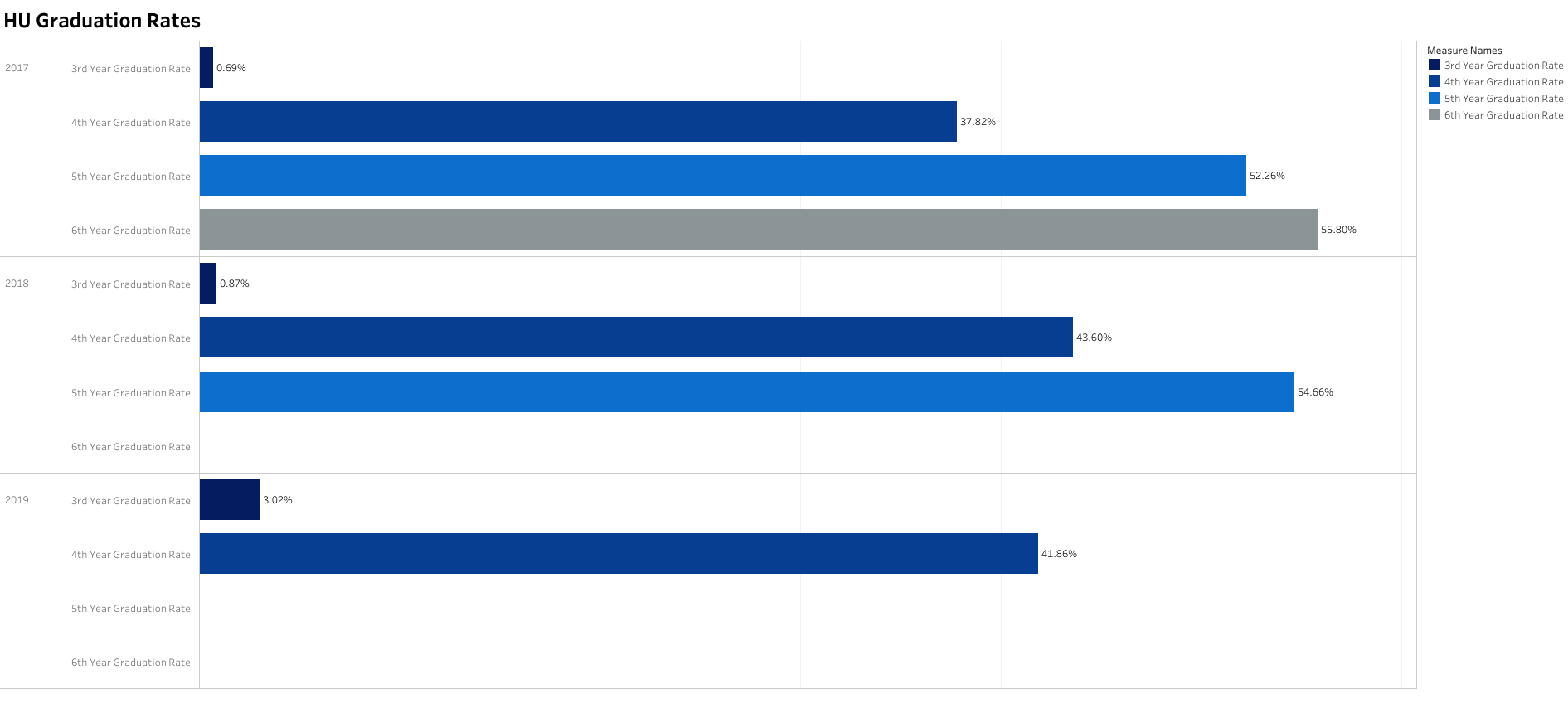
STRATEGIES AND KEY PERFORMANCE INDICATORS
Key Performance Indicators
a. Implement a technology-based intrusive academic advising and early alert system that provides real-time monitoring to a centralized team.
b. Ensure 100% of undergraduate students participate in at least one extracurricular activity to strengthen academic success.
c. Eliminate the cost of textbooks for undergraduates through a combination of electronic books and
philanthropic support.
d. Reduce the average student loan indebtedness to the lowest among the top ten ranked HBCUs.
e. Re-engineer the fiscal support options that fund the cost of attending Hampton University to increase
the average institutional support contribution by 50% over baseline.
f. Increase the University’s first-year student retention rate by 40% over baseline.
g. Increase the number of world-class performances of student artists by 25% over baseline.
h. Increase the University’s six-year graduation rate by 25% over baseline.
i. Charter a chapter of Phi Beta Kappa Society.
j. Increase the number of bilingual undergraduate students through university-wide initiatives by
25% over baseline.
k. Increase the number of students engaged in international study by 40% over baseline.
Key Performance Indicators
a. Establish the School of Religion.
b. Establish the School of Leadership Studies.
c. Establish the College of Health Sciences and Research.
d. Establish a degree in logistics and supply chain management.
e. Elevate superior critical communication skills as a core skill.
f. Increase the number of certified PK-12 teachers graduating by 25% over baseline. STRATEGIC PLAN 2023–2033 | 7
g. Increase the number of students in the visual and performing arts by 25% over the baseline to advance Hampton’s legacy in the arts.
h. Increase the micro-credential inventory by 25% over baseline.
i. Reduce the percentage of courses being taught by part-time faculty to less than 25%.
j. Reduce the number of classes larger than twenty students to less than 10% of all classes in the university.
k. Expand online instruction to 50% of the degree inventory.
l. Reduce average university time and costs to achieve advanced degrees.
Key Performance Indicators
a. Replace paper-based processes and employ technology driven methods wherever possible.
b. Standardize faculty searches and interview process.
c. Convert all student-interfacing systems to mobile technology-based operations.
d. Convert all human resources systems to high touch technology-based systems.
e. Implement technical monitoring equipment for leaders to measure and monitor classroom environments to ensure optimum knowledge transfer.
f. Increase Hampton’s academic profile based on survey data.
g. Conduct a policy evaluation that increases faculty satisfaction with the services.
h. Increase the number of departments identified in the top 25% of departments nationwide by 50% over baseline.
i. Reduce faculty teacher ratio to lowest among HBCUs with 2,000 or more students.
j. Achieve 100% placement in graduate or professional schools within six months of graduation for those who do not transition directly into the work force.
k. Increase mental health, safety, and wellness services for students, faculty, and staff by 25%.
Key Performance Indicators
a. Fill the positions in the Capacity Building Initiative to address faculty teaching load, policies, procedures, and budgets.
b. Complete the Hampton R1 Faculty Plan to guide the strategic acquisition of new research faculty.
c. Implement a competitive faculty recruitment incentives package.
d. Offer retirement incentive plans to strengthen the University’s faculty profile.
e. Increase the percentage of full-time faculty with a terminal degree to 99%.
f. Increase the percentage of Hampton faculty elected to membership in national academies and honor societies by 25% over baseline.
g. Increase the number of faculty winning international and national fellowships and awards annually by 25% over baseline.
h. Increase diversity (credentials, disciplines, geography, gender, age, etc.) in the faculty.
i. Increase the percent of full-time faculty holding terminal degrees from R1 universities to 75%.
Key Performance Indicators
a. Increase the number of high school valedictorians and salutatorians in the first year class.
b. Employ innovative strategies to develop high functioning 2+2 agreements with Virginia Community and Technical colleges.
c. Increase the number of students graduating in the top 10% of their classes by 20% over baseline.
d. Develop a comprehensive agenda for the Terpsichorean Dance Company that includes a traveling tour.
e. Develop a comprehensive plan for the creation and sustainability of a world-class Hampton University Jazz Ensemble.
Key Performance Indicators
a. Increase the number of African American students pursuing masters at Hampton by 25% over baseline.
b. Increase the number of African American students pursuing masters at Hampton by 75% over baseline.
c. Produce annual increases in the number of African American students pursuing masters at Hampton.
d. Increase number of African American students pursuing doctorates at Hampton by 25% over baseline.
e. Increase number of African American students pursuing doctorates at Hampton by 75% over baseline.
f. Produce annual increases in the number of African American students pursuing doctorates at Hampton.
g. Increase number of Latino students pursuing masters at Hampton by 25% over baseline.
h. Increase number of Latino students pursuing masters at Hampton by 75% over baseline.
i. Produce annual increases in the number of Latino students pursuing masters at Hampton.
Key Performance Indicators
a. Increase the number of students pursuing degrees online at Hampton by 25% over baseline.
b. Increase the number of students pursuing degrees online at Hampton by 50% over baseline.
c. Annually increase the number of students pursuing degrees online at Hampton.

1.1 Enhance the academic experience to increase student’s success as defined by graduation, retention, and persistence rates.
Key Performance Indicators
a. Implement a technology-based intrusive academic advising and early alert system that provides real-time monitoring to a centralized team.
b. Ensure 100% of undergraduate students participate in at least one extracurricular activity to strengthen academic success.
c. Eliminate the cost of textbooks for undergraduates through a combination of electronic books and philanthropic support.
d. Reduce the average student loan indebtedness to the lowest among the top ten ranked HBCUs.
e. Re-engineer the fiscal support options that fund the cost of attending Hampton University to increase the average institutional support contribution by 50% over baseline.
f. Increase the University’s first-year student retention rate by 40% over baseline.
g. Increase the number of world-class performances of student artists by 25% over baseline.
h. Increase the University’s six-year graduation rate by 25% over baseline.
i. Charter a chapter of Phi Beta Kappa Society.
j. Increase the number of bilingual undergraduate students through university-wide initiatives by 25% over baseline.
k. Increase the number of students engaged in international study by 40% over baseline.
1.2 Continuously evaluate and expand the academic inventory to offer liberal arts, select market-driven credentials, and workforce development initiatives to broaden Hampton University influence in the United States and abroad.
Key Performance Indicators
a. Establish the School of Religion.
b. Establish the School of Leadership Studies.
c. Establish the College of Health Sciences and Research.
d. Establish a degree in logistics and supply chain management.
e. Elevate superior critical communication skills as a core skill.
f. Increase the number of certified PK-12 teachers graduating by 25% over baseline. STRATEGIC PLAN 2023–2033 | 7
g. Increase the number of students in the visual and performing arts by 25% over the baseline to advance Hampton’s legacy in the arts.
h. Increase the micro-credential inventory by 25% over baseline.
i. Reduce the percentage of courses being taught by part-time faculty to less than 25%.
j. Reduce the number of classes larger than twenty students to less than 10% of all classes in the university.
k. Expand online instruction to 50% of the degree inventory.
l. Reduce average university time and costs to achieve advanced degrees.
1.3 Review, reorganize, and strengthen university priorities, policies, and procedures to support a Hampton University faculty well-positioned to deliver the University’s research agenda to an increasingly larger population of undergraduate, graduate, and online students while delivering the #1 student experience in America.
Key Performance Indicators
a. Replace paper-based processes and employ technology driven methods wherever possible.
b. Standardize faculty searches and interview process.
c. Convert all student-interfacing systems to mobile technology-based operations.
d. Convert all human resources systems to high touch technology-based systems.
e. Implement technical monitoring equipment for leaders to measure and monitor classroom environments to ensure optimum knowledge transfer.
f. Increase Hampton’s academic profile based on survey data.
g. Conduct a policy evaluation that increases faculty satisfaction with the services.
h. Increase the number of departments identified in the top 25% of departments nationwide by 50% over baseline.
i. Reduce faculty teacher ratio to lowest among HBCUs with 2,000 or more students.
j. Achieve 100% placement in graduate or professional schools within six months of graduation for those who do not transition directly into the work force.
k. Increase mental health, safety, and wellness services for students, faculty, and staff by 25%.
1.4 Develop a comprehensive faculty assessment and transition plan that guidesthe university in successfully transitioning existing faculty assetsinto world-class faculty that advances the University’s R1 aspirations.
Key Performance Indicators
a. Fill the positions in the Capacity Building Initiative to address faculty teaching load, policies, procedures, and budgets.
b. Complete the Hampton R1 Faculty Plan to guide the strategic acquisition of new research faculty.
c. Implement a competitive faculty recruitment incentives package.
d. Offer retirement incentive plans to strengthen the University’s faculty profile.
e. Increase the percentage of full-time faculty with a terminal degree to 99%.
f. Increase the percentage of Hampton faculty elected to membership in national academies and honor societies by 25% over baseline.
g. Increase the number of faculty winning international and national fellowships and awards annually by 25% over baseline.
h. Increase diversity (credentials, disciplines, geography, gender, age, etc.) in the faculty.
i. Increase the percent of full-time faculty holding terminal degrees from R1 universities to 75%.
1.5. Build a nationally competitive undergraduate population of 5,000 students prepared to undertake a rigorous course of study leading to leadership placement in the workforce or post-baccalaureate study.
Key Performance Indicators
a. Increase the number of high school valedictorians and salutatorians in the first year class.
b. Employ innovative strategies to develop high functioning 2+2 agreements with Virginia Community and Technical colleges.
c. Increase the number of students graduating in the top 10% of their classes by 20% over baseline.
d. Develop a comprehensive agenda for the Terpsichorean Dance Company that includes a traveling tour.
e. Develop a comprehensive plan for the creation and sustainability of a world-class Hampton University Jazz Ensemble.
1.6 Build a nationally competitive graduate population of 1,000 minority students prepared to undertake a rigorous course of study leading leadership placement in the workforce or postbaccalaureate study that positions Hampton to provide transformative and culturally relevant solutions-oriented leadership around the globe in teaching, research, service, and creative works.
Key Performance Indicators
a. Increase the number of African American students pursuing masters at Hampton by 25% over baseline.
b. Increase the number of African American students pursuing masters at Hampton by 75% over baseline.
c. Produce annual increases in the number of African American students pursuing masters at Hampton.
d. Increase number of African American students pursuing doctorates at Hampton by 25% over baseline.
e. Increase number of African American students pursuing doctorates at Hampton by 75% over baseline.
f. Produce annual increases in the number of African American students pursuing doctorates at Hampton.
g. Increase number of Latino students pursuing masters at Hampton by 25% over baseline.
h. Increase number of Latino students pursuing masters at Hampton by 75% over baseline.
i. Produce annual increases in the number of Latino students pursuing masters at Hampton.
1.7 Build an online population of 5,000 students.
Key Performance Indicators
a. Increase the number of students pursuing degrees online at Hampton by 25% over baseline.
b. Increase the number of students pursuing degrees online at Hampton by 50% over baseline.
c. Annually increase the number of students pursuing degrees online at Hampton.
STRATEGIES AND KEY PERFORMANCE INDICATORS
1.1 Enhance the academic experience to increase student’s success as defined by graduation, retention, and persistence rates.
1.2 Continuously evaluate and expand the academic inventory to offer liberal arts, select market-driven credentials, and workforce development initiatives to broaden Hampton University influence in the United States and abroad.
1.3 Review, reorganize, and strengthen university priorities, policies, and procedures to support a Hampton University faculty well-positioned to deliver the University’s research agenda to an increasingly larger population of undergraduate, graduate, and online students while delivering the #1 student experience in America.
1.4 Develop a comprehensive faculty assessment and transition plan that guides the university in successfully transitioning existing faculty assetsinto world-class faculty that advances the University’s R1 aspirations.
1.5. Build a nationally competitive undergraduate population of 5,000 students prepared to undertake a rigorous course of study leading to leadership placement in the workforce or post-baccalaureate study.
1.6 Build a nationally competitive graduate population of 1,000 minority students prepared to undertake a rigorous course of study leading leadership placement in the workforce or post-baccalaureate study that positions Hampton to provide transformative and culturally relevant solutions-oriented leadership around the globe in teaching, research, service, and creative works.
1.7 Build an online population of 5,000 students.
ELEVATE ACADEMIC EXCELLENCE
GOAL
REIMAGINE THE HAMPTON ACADEMIC EXPERIENCE TO DEVELOP INNOVATIVE 21ST-CENTURY LEADERS OF CHARACTER FOR OUR COMMUNITY, OUR NATION, AND OUR WORLD.
INTRODUCTION
Hampton University positions academic excellence front and center among its goals so that it remains: a clear focus, an institutional standard, and a promise to university stakeholders as the entire Hampton family endeavors to deliver the #1 student experience in America. The strategies to achieve the principal goal are developed around the following: academic experience; academic inventory; policies, procedures, faculty; and undergraduate, graduate, and online enrollment.
STRATEGIES AND KEY PERFORMANCE INDICATORS
Key Performance Indicators
a. Implement a technology-based intrusive academic advising and early alert system that provides real-time monitoring to a centralized team.
b. Ensure 100% of undergraduate students participate in at least one extracurricular activity to strengthen academic success.
c. Eliminate the cost of textbooks for undergraduates through a combination of electronic books and philanthropic support.
d. Reduce the average student loan indebtedness to the lowest among the top ten ranked HBCUs.
e. Re-engineer the fiscal support options that fund the cost of attending Hampton University to increase the average institutional support contribution by 50% over baseline.
f. Increase the University’s first-year student retention rate by 40% over baseline.
g. Increase the number of world-class performances of student artists by 25% over baseline.
h. Increase the University’s six-year graduation rate by 25% over baseline.
i. Charter a chapter of Phi Beta Kappa Society.
j. Increase the number of bilingual undergraduate students through university-wide initiatives by 25% over baseline.
k. Increase the number of students engaged in international study by 40% over baseline.

